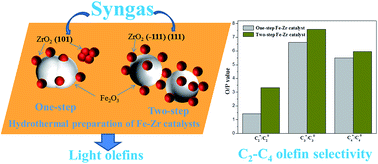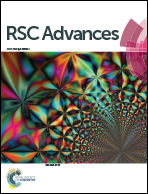Hydrothermal preparation of Fe–Zr catalysts for the direct conversion of syngas to light olefins
Abstract
Fe/Zr precursors were prepared by a one-step and two-step hydrothermal process respectively, following K promotion by incipient wetness impregnation, which then were used for the selective production of C2–C4 olefins via Fischer–Tropsch synthesis from syngas. The textural properties, phase structure, reduction behavior and the catalytic performance of the obtained catalyst samples were greatly affected by different preparation procedures. The T–Fe/Zr samples prepared by the two-step hydrothermal process caused a decrease in the surface area and easier reduction of iron species compared with that of the O–Fe/Zr samples prepared by the one-step hydrothermal process. The T–Fe/Zr samples before and after K promotion showed preferred orientation along the (−111) and (111) lattice planes of ZrO2 in contrast to the ZrO2 (101) lattice plane on O–Fe/Zr samples. For CO hydrogenation, all the catalysts exhibited high activity and good stability. The T–Fe/Zr–K catalysts with highly dispersed zirconia on the iron surface could prevent Fe–Zr mixed oxide formation by decreasing the interaction between iron and zirconia, leading to a slight increase in C2–C4 olefin selectivity and improvement on the product distribution.


 Please wait while we load your content...
Please wait while we load your content...